
Mark 1 Models 1/144 He-219A-7 'Uhu'
| KIT #: | MKM 14427 |
| PRICE: | $20.00 or so |
| DECALS: | Four options |
| REVIEWER: | Ingemar Caisander |
| NOTES: |

| HISTORY |
The Heinkel He 219 "Uhu" (Eagle Owl) was the only Luftwaffe fighter designed from the outset as a dedicated night fighter, and it was planned as a counterpart to the RAF night fighter versions of the de Havilland "Mosquito". The He 219 prototype took to the air on 15 November, 1942. The design proved an instant success; being powerful, manouverable, and having good flying characteristics. Its top speed of up to 585 kph at an altitude of 6,000 meters in combination with the powerful on-board radar equipment meant that the "Uhu" could intercept enemy bombers en-route to their targets, instead of having to wait until they were reported by ground based stations. This capable night fighter also sported the world’s first operational ejection seats.
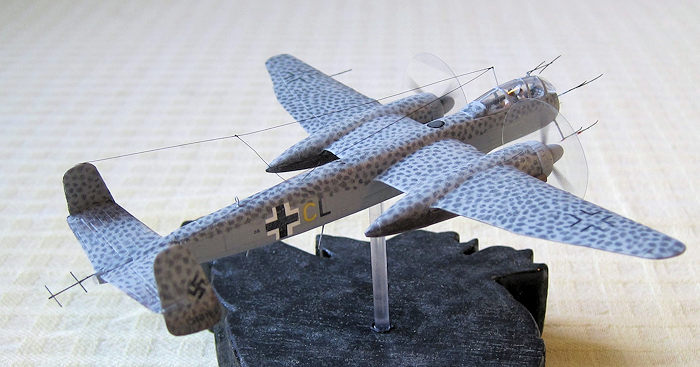 Armament
consisted of one autocannon mounted in each wing root and two to four
further autocannons in a ventral tray. In addition, provision was also made
for mounting two 30mm MK 108 autocannons in the rear fuselage. These guns,
known as "Schräge Muzik" and aimed through a separate Revi 16 A-N gunsight,
were angled forward and upwards at 65 degrees, allowing the night fighter to
engage Allied four-engined bombers from their blindspot. Firing non-tracer
rounds, these guns proved highly effective. During the first experimental
mission, flown on the night of 11-12 June, 1943, Major Werner Streib managed
to stalk and shoot down no less than five British four-engined bombers,
heading for Berlin, in just 30 minutes!
Armament
consisted of one autocannon mounted in each wing root and two to four
further autocannons in a ventral tray. In addition, provision was also made
for mounting two 30mm MK 108 autocannons in the rear fuselage. These guns,
known as "Schräge Muzik" and aimed through a separate Revi 16 A-N gunsight,
were angled forward and upwards at 65 degrees, allowing the night fighter to
engage Allied four-engined bombers from their blindspot. Firing non-tracer
rounds, these guns proved highly effective. During the first experimental
mission, flown on the night of 11-12 June, 1943, Major Werner Streib managed
to stalk and shoot down no less than five British four-engined bombers,
heading for Berlin, in just 30 minutes!
Built in rather limited numbers, most He 219 served with NJG 1. The He 219 A-7 was introduced in January 1945 and was a refined development of the second main production variant, the He 219 A-2. Featuring a lighter airframe, strengthened armour, reduced armament, and planned to use the more powerful DB603G engines, the He 219 A-7 was arguably the best "Uhu" produced to date.
It replaced the various earlier radar installations with a new model: the highly advanced FuG 220 "Lichtenstein" SN-2d, featuring dipoles angled at 45 degrees for less interference, and in a few aircraft also a second circuit connected to a rearward facing aerial (known as the FuG 220 "Neptun"). The maximum range of this sophisticated radar set was up to 8,000 meters, with a theoretical minimum range of 200 meters (seldom accomplished in service, though; a minimum range of 450-500 meters was more common).
A total of only about 60 He 219 A-7 were built, and most (if not all) of these carried the reduced armament of one 20mm MG 151/20 autocannon in each wingroot, and a further two MG 151/20 in the ventral tray. Each weapon was supplied with 300 rounds of ammunition. In addition to this, two 30mm MK 108 autocannons with 100 rounds per gun could be carried in the rear fuselage in a "Schräge Muzik" installation.
The He 219 A-7 was initially planned
to use the 1900hp DB603G engine, but due to severe production problems of
this powerplant, the 1800hp DB603E was substituted. As this engine soon also
proved difficult
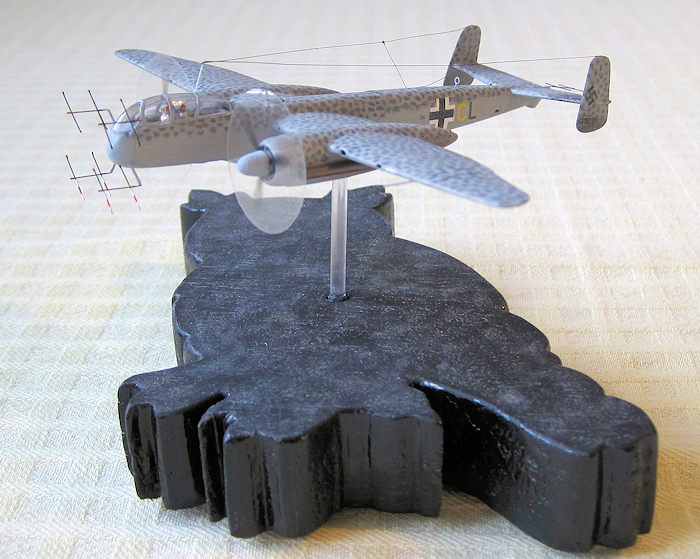 to
aquire, many A-7s had to revert to the older DB603A with a take-off rating
of 1750hp. This hampered performance but thanks to the lightened airframe
and reduced armament, the He 219 A-7 was still one of the fastest "Uhu"
produced.
to
aquire, many A-7s had to revert to the older DB603A with a take-off rating
of 1750hp. This hampered performance but thanks to the lightened airframe
and reduced armament, the He 219 A-7 was still one of the fastest "Uhu"
produced.
According to some sources, six special He 219 A-7 "Uhu" were constructed in April 1945, just before the war ended. What made them special is that they were built from spare parts in a forest assembly plant at Werl, Germany. They are not listed in any official production documentation and apparently carried no Werknummer.
Today, the restored fuselage and engine nacelles of the (until recently) only known surviving He 219 A-2 (Werknummer 290202) is on display at the Steven F. Udvar-Hazy Center by Dulles Airport, with the wings still undergoing restoration at the Paul E. Garber Facility in Silver Hill, Maryland. This aircraft was one of seven He 219s captured in (or near) airworthy condition at the Karup/Grove base of NJG 1 in South Jutland, Denmark, at the end of the war.
Incredibly, though, in April 2012 another previously unknown He 219 A-7 was salvaged from the seabed in the shallow waters of Tannis Bay north of Hirtshals, Denmark. Although severly damaged and missing many parts, the remains of this aircraft was preserved and then put on display at the Forsvars- og Garnisonsmuseum in Aalborg, Denmark. In August 2015 it was announced that the wreckage had been sold to an Austrian enthusiast for further restoration.
| THE KIT |
This is one of the three new-tool 1/144 scale He 219 kits released by Mark 1. Models in 2014. All three kits, a He 219 A-2 (MKM14419), a He 219 A-5 (MKM14425), and a He 219 A-7 (MKM14427), are basically identical with just different boxes and decals supplied. A fourth kit (MKM14449) of a He 219 A-0/LB-79 was released in 2016. Although I have not seen this kit IRL, I suspect it is identical to the earlier three, with just a new box and different decals.
The light grey plastic parts of the kit
are very nice and, despite the small size, rather well detailed. General
dimensions appear to be correct and there is just a bit of flash present. All
panel lines are recessed. Total parts count is 35, plus one very nice clear
canopy. The plastic parts of the kit is somewhat on the soft side and require a
bit of care when cutting and sanding, but it reacts well to ordinary model glue.
Fit is good 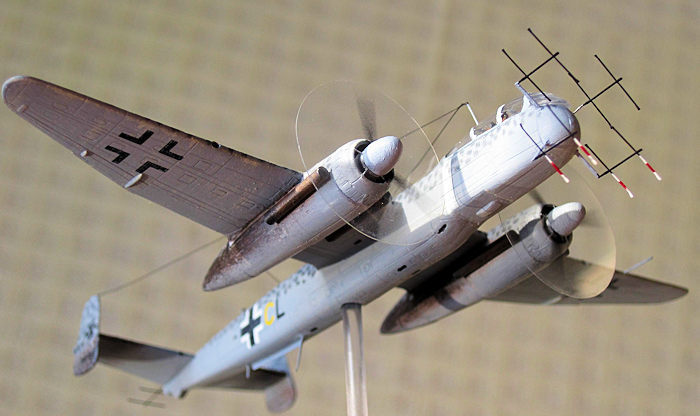 although
a bit of sanding and filler is required now and then.
although
a bit of sanding and filler is required now and then.
Also included in the kit is a photo-etched fret with cockpit details such as seats, seatbelts, foot pedals, and instrument panels. The main radar aerials, details for the undercarriage, and some other small bits and pieces are also represented in PE form. Some of the smallest PE pieces are thoughtfully duplicated on the sheet – a nice touch.
You also get a display base in the form of a colour printed card of a typical Luftwaffe concrete slab airfield – this will be a good starting point for a small diorama. Instructions are easy to follow and basically consist of a parts map, six main assembly steps, and painting and marking options in full colour.
A total of four marking options are provided: W.Nr. 310193 operated by the Luftwaffe in spring 1945; G9+SK of 2./NJG 1 based at Münster-Handorf in Germany, spring 1945; D5+CL (W.Nr. 310189) of 3./NJG 3 based at Grove AB in Denmark, April 1945; and finally "Air Ministry 22", a surrendered He 219 evaluated by the Royal Aircraft Establishment at Farnborough, England, in 1945-46.
It should be noted that the last two entries are actually the one and same aircraft: D5+CL (W.Nr. 310189) was a Rostock-Marienehe-produced He 219 A-7, operated by NJG3 and found in good condition together with six other He-219s at the Karup/Grove Air Base in May 1945. It was given the British designation "AM22" ("Air Ministry 22") before being shipped over to the UK on August 27, 1945, for evaluation. This aircraft was rather well documented and displayed at various air shows just after the war.
The first of the other two decal options, W.Nr.310193, was an He 219 A-7 found damaged at Halle in May 1945, while the second option, G9+SK, was one of the twenty He 219s damaged or destroyed in the Allied raid on Münster/Handorf on 21-22nd March, 1945.
One peculiar thing with the decal sheet is that it doesn’t include correct upper wing markings – the decals provided are of the "filled-in" Balkenkreuz type, and not the correct black single outline crosses. These nitpicks aside, the decals are very nice and in perfect register. Swastikas are included.
| CONSTRUCTION |
Construction began with the cockpit – it basically consist of a plastic floor with photo-etched seats and details. The PE seats were bent according to the instructions, painted dark grey, and then installed using super glue. As I intended to finish this model in flying condition, I skipped the PE seat belts and instead added two scratchbuilt crew members to the cockpit. The perforated PE instrument panel was painted dark grey at the front, and white at the back. By using a needle I managed to get the white paint to flow across the perforations, thereby nicely imitating the instrument faces.
The rear radar control panel is placed a bit too far back in the cockpit, so I beefed up the area behind it. If you are building this model with the landing gear down, this will be a great place to add ballast in order to prevent the model from being a tail-sitter – natural places for this added weight are in the nose (behind the instrument panel as well as beneath the cockpit floor), in the front of the engine nacelles, and behind the rear radar controls. Should this prove not enough, there´s quite a bit of ballast space in the fuselage just behind the cockpit. Remember to use either white glue or standard plastic glue if you add lead weights, as super glue has a tendency to "expand" the lead over time (in worst case leading to a cracked fuselage).
The fuselage halves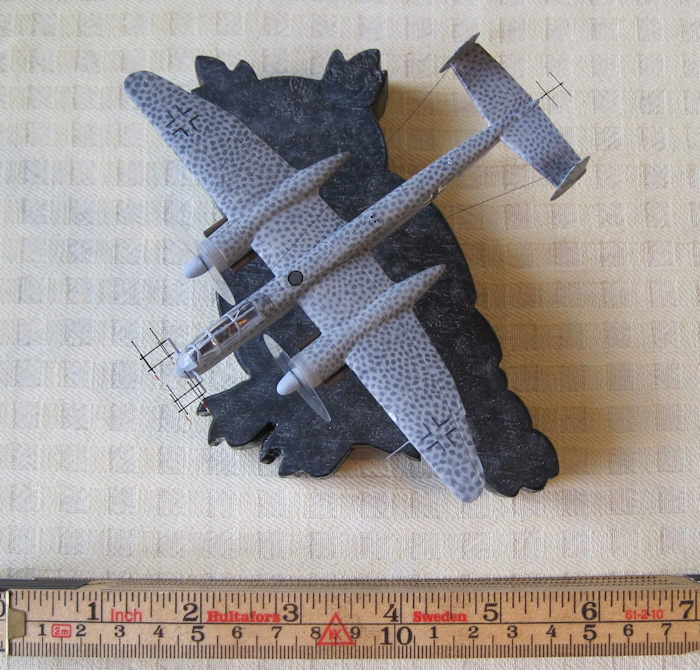 were cemented together, trapping the completed cockpit inbetween. The outermost
autocannon muzzles in the ventral tray are nicely represented by small
indentations, but the centre muzzles are missing. For the A-7 this is not a
problem, though, as usually only the outermost cannons were fitted, with the
inner muzzle openings faired over.
were cemented together, trapping the completed cockpit inbetween. The outermost
autocannon muzzles in the ventral tray are nicely represented by small
indentations, but the centre muzzles are missing. For the A-7 this is not a
problem, though, as usually only the outermost cannons were fitted, with the
inner muzzle openings faired over.
The main wings are molded as one solid piece and feature very nice details. I drilled open the main air intakes for the DB603 engines, as well as the gun muzzles for the wing root autocannons, and also the small intakes for the Kärcher-Öfen BL 30/U wing de-icing heaters. The intakes for these latter units are positioned in the outer wing leading edge and are a bit tricky to drill out correctly, as the wing is rather thin at this position. The wing root gun muzzles were also drilled open, as were the openings for the "Schräge Muzik" guns in the upper rear fuselage.
The front end of the radiator cowlings received the typical five small braces – these are rather prominent on the real aircraft, but were not represented on the kit parts. A little bit of filler and sanding was needed in order to blend in the lower engine nacelle with the upper fixed part on the wing. For a more realistic look, I also drilled out the end section of the cylindrical flame arrestors for the engine exhausts.
To imitate running engines for the "in-flight" configuration, I carefully cut off the propeller blades and then a circular dish of transparent plastic film, with printed-on blurred representations of spinning blades, was cut out and glued to the backside of the spinner.
The entire tailplane assembly is made up from three parts, and the only modification needed is to drill open the small air intake for the rear fuselage Kärcher-Öfen BL 30/U de-icing heater – this intake is located in the leading edge of the right tailplane, just a small distance out from the fuselage. Note that kit part #6, the end piece for the fuselage, should have its extreme tip cut off and replaced by a piece of clear plastic.
All undercarriage doors were cemented in the closed position and a clear plastic support rod was glued to the fuselage underside. With all the major assembly work completed, it was time to hit the paint booth.
| COLORS & MARKINGS |
W.Nr.310189 / D5+CL carried a typical He 219 camouflage scheme of RLM 75 Grauviolett on the upper surfaces, with RLM 76 Lichtblau on the undersides. Furthermore, the upper fuselage and wings featured a rather dense "squiggle" pattern of RLM 76 sprayed over the base Dark Grey color. The propellers were finished in RLM 70 Schwarzgrün, while the spinners were RLM 76 with very faded white spirals.
I began by priming the entire aircraft in diluted off-white (Humbrol 121), followed by a base coat of RLM 76 (Revell 76), this light blue coat was also diluted with thinner so not to loose any surface details. The upper surfaces of the wings and fuselage were then mottled with RLM 75 (Humbrol 125) using a semi-drybrushing technique. Although this sort of mottling is easier to do using an airbrush, I had to imitate the sprayed-on appearance of the paint the best I could, as I always brush paint my models.
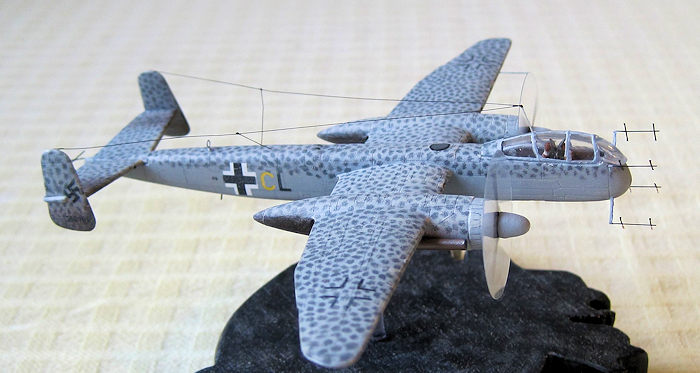 In
real life during the war, the colours were also actually applied the other way
round - that is, the upper dark grey RLM 75 (or, in some cases, RLM 74 Graugrün)
was painted first and then oversprayed with lightblue RLM 76 in a squiggle
pattern. The spinners were finished in RLM 76, with the "rotating" propellers
imitated by clear plastic dishes as mentioned before.
In
real life during the war, the colours were also actually applied the other way
round - that is, the upper dark grey RLM 75 (or, in some cases, RLM 74 Graugrün)
was painted first and then oversprayed with lightblue RLM 76 in a squiggle
pattern. The spinners were finished in RLM 76, with the "rotating" propellers
imitated by clear plastic dishes as mentioned before.
The FuG 220 radar dipoles were painted flat black, with the lowermost four aerials of the front radar sectioned in white and red (Humbrol 34 and 19) as a ground crew warning. The exhaust flame arrestors were painted brown (Humbrol 62) and then treated with graphite powder, and the cockpit interior was finished in dark grey (Humbrol 79), and then gently drybrushed with off-white (Humbrol 121).
After drying a couple of days, the model was gloss-coated in preparation for the decals. These went on without any problem. As the correct upper wing markings (single outline black crosses) were missing on the decal sheet supplied, I used a pair from another kit instead.
The entire model was clearcoated with flat varnish and then it was time for weathering. This was kept rather limited: the He 219s were the "Cadillacs" of the Luftwaffe and they were usually well maintained and kept in good condition. I did a light overall drybrushing with off-white (Humbrol 121) on the fuselage and wings, and then some rather heavy brown, black, and grey soothing behind the engine exhausts. As the DB603s were notoriously "dirty" powerplants, as well as the German aviation fuel this late in the war being of sub-standard quality, I also let the engine exhaust sooth trail continue onto the tailplanes.
With general painting, decaling, and weathering completed, it was time for final assembly. This included adding the FuG 16ZY radio and FuG 25A IFF masts under the rear fuselage; both these masts are supplied as PE parts in the kit. The main FuG 10P radio aerials, stretching from the front dorsal mast (fabricated from a piece of stretched sprue as I didn’t like the PE mast of the kit) and to both tailfins, were made from very thin copper strand. This wire was wound off from a small radio coil and then carefully burnt with a cigarette lighter to remove the laquer insulation and give the wire a dark, oxidized look. The aerials with connecting leads between the main wires and the rear fuselage were attached with tiny drops of superglue. The rear fuselage trailing FuG 220 antenna was supplied as a PE part in the kit, and just painted flat black before being superglued to the tail of the aircraft.
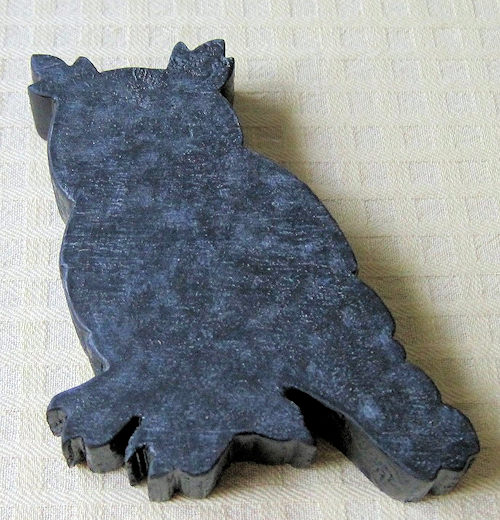 All
shell ejector chutes were imitated by small rectangular dots of black paint. On
the fuselage underside there should be a total of three chutes: one for each of
the ventral outer MG151/20 autocannons, with a further chute at the rear for the
"Schräge Muzik"
– note that these two upward firing guns ejected their empty casings through a
common opening.
All
shell ejector chutes were imitated by small rectangular dots of black paint. On
the fuselage underside there should be a total of three chutes: one for each of
the ventral outer MG151/20 autocannons, with a further chute at the rear for the
"Schräge Muzik"
– note that these two upward firing guns ejected their empty casings through a
common opening.
On either inner wing, roughly at the centre line and just next to the fuselage, there should be a further ejection chute for the wing root autocannons. The small exhaust outlet for the rear fuselage Kärcher-Öfen BL 30/U de-icing heater was imitated in the same way – this exhaust port is located below and just in front of the left tailplane.
As bottom support for the model, I cut out a piece of wood in the shape of an eagle owl (“Uhu” in German). This was then painted gloss black on the sides and flat black on the top, followed by some drybrushing with ivory-white (Humbrol 121) to give it sort of an “nocturnal” feel. A 3mm hole was drilled in the center and then the clear support rod, previously attached to the model, was cemented in place.
| CONCLUSIONS |
Mark 1. certainly has done well in producing this little replication of the most advanced German nightfighter of WWII. The completed model will only take up a fraction of shelf space, and with just a little bit of TLC and attention to details, a very realistic model can be made.
Highly recommended!
| REFERENCES |
"Heinkel He 219 Uhu" by Marek Rys, Aircraft Monograph 21 (AJ Press 2008)
"Heinkel He 219 Uhu Vol I & II" by M. Murawski & M. Rys, 3D Monographs 49 & 50 (Kagero 2012 & 2013)
"The Heinkel He 219 Uhu" by Richard A. Franks, Airframe Album 1 (Valiant Wings 2012)
"Wings of the Luftwaffe" by Eric Brown (Hikoki 2010)
"The Heinkel He 219 – A Research Paper" (3rd Ed.) by R. Francis Ferguson (2012)
Ingemar Caisander
10 November 2016
Copyright ModelingMadness.com
Thanks t
If you would like your product reviewed fairly and fairly quickly, please contact the editor or see other details in the Note to Contributors.